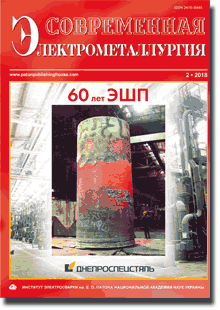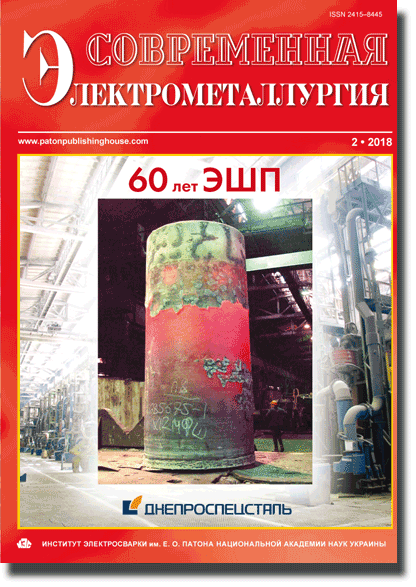| 2018 №02 (02) |
DOI of Article 10.15407/sem2018.02.03 |
2018 №02 (04) |

Современная электрометаллургия, 2018, #2, 28-36 pages
Современные рельсовые стали и возможности ЭШП (Обзор). Сообщение 2. Требования стандартов к химическому составу стали для железнодорожных рельсов магистральных путей
. Б. Медовар, А. П. Стовпченко, А. А. Полишко, Д. А. Коломиец, Е. А. Педченко, В. А. Зайцев
Институт электросварки им. Е. О. Патона НАН Украины. 03150, г. Киев, ул. Казимира Малевича, 11. E-mail: office@paton.kiev.ua
Abstract
Сделано сравнение отечественного стандарта на железнодорожные рельсы и современных зарубежных. Показано, что в Украине требования к железнодорожным рельсам значительно мягче по сравнению с зарубежными и не обеспечивают современного уровня их качества. Проанализирована связь современных металлургических технологий производства рельсов и их качества, в частности возможности использования вакуум-углеродного раскисления рельсовой стали и отказа от раскисления алюминием. Показана целесообразность разработки нового стандарта Украины на железнодорожные рельсы и возможность использования электрошлакового переплава для рельсов высокого качества. Библиогр. 27, табл. 3.
Ключевые слова: железнодорожные рельсы; рельсовые стали; бейнитные; перлитные; гиперэвтектоидные; вакуум-углеродное раскисление; макроструктура; электрошлаковый переплав; стандарт
Received: 02.05.18
Published: 25.05.18
Список литературы/References
- (2007) Railway applications–track–rail. Pt 1: Vignole railway rails 46 kg/m and above. EN 13674-1:2003+А1:2007.
- Vitez, I., Oruč, M., Krumes, D., Kladarić, I. (2007) Damage to railway rails caused by exploitation. Metalurgija, 46(2), 123–128.
- (2005) Steels: Processing, structure, and performance (#05140G. Сhapt. 15. High-carbon steels: Fully pearlitic microstructures and applications. ASM International. https://www.asminternational.org/documents/10192/1849770/Chapter_15_WEB.pdf
- https://www.voestalpine.com/schienen/static/sites/schienen/.downloads/Definitive_guidelines_on_the_use_of_different_rail_grades_xINNOTRACK_deliverable_report_D4._1.5GLx_nur_in_Englisch_verfuegbarx.pdf
- Conventional rails of road-gage railways. General specifications. DSTU 4344:2004. Kyiv, Derzhspozhyvstandart Ukrainy [in Ukrainian].
- (2014) Railway rails. General specifications. GOST R 51 685–2013 [in Russian].
- Saeki, K., Iwano, K. (2013) Progress and prospects of rail for railroads Nippon Steel & Sumitomo Metal. Technical Report, 105, 21–25.
- Girsch, G., Keichel, J., Gehrmann R. et al. (2009) Advanced rail steels for heavy haul application-track performance and weldability. In: of 9th Int. Heavy Haul Conf. (Shanghai, China, June 22–25, 2009), 171–178.
- Ordonez, R., Garcsal, C. I., Kalay, S., Deardo, J. (2010) Development of high performance steels for rail. In: of Joint Rail Conf. 2010, 1 (Urbana, Illinois, USA, April 27–29, 2010), 129–133.
- Dementiev, V.P., Korneva, L.V., Serpiyanov, A.I. et al. (2007) Technology of production and exploitation of experimental rails NKMK on East Siberian Railway. In: of All-Russian Sci.-Pract. Conf. on Problems and Prospects of Research, Design, Construction and Exploitation of Russian Railways (10–11 October 2007, Irkutsk), Vol. 1, 29–34 [in Russian].
- Pan, A.V. Development and implementation of new technologies for current and prospective production of rails: Syn. of Thesis for Dr. of Techn. Sci. Degree. Moscow [in Russian].
- Jin, N., Clayton, P. (1997) Effect of microstructure on rolling/sliding wear of low carbon bainitic steels. Wear, 202(2), 202–207.
- Marais, J. J., Mistry, K. C. (2003) Rail integrity management by means of ultrasonic testing. Fatigue & Fract. of Eng. Mat. & Struct., 26(10), 931–938.
- Mädler, K., Zoll, A., Heyder, R., Brehmer, M. Rail materials — alternatives and limits. www.railway-research.org.sl.3.4.1.pdf
- Solano-Alvarez, W., Peet, M.J., Pickering, E.J. et al. (2017) Synchrotron and neural network analysis of the influence of composition and heat treatment on the rolling contact fatigue of hypereutectoid pearlitic steels. Sci. and Engin., 707, 259–269.
- Sychkov, A.B., Zhigarev, M.A., Perchatkin, A.V. et al. (2006) High-carbon rod from steel with higher chromium content. Metallurg, 4, 59–62 [in Russian].
- Zazyan, A.S. (2006) Regulation of amount and composition of nonmetallic inclusions during performance of out-of-furnace treatment of high-carbon steel. Metallurgiya, 10, 40–44 [in Russian].
- (2017) Advantages of Si deoxidation of bearing steels for steel cleanness and for composition and morphology of nonmetallic inclusions. Bearing steel technologies. Ed. by J. M. Beswick. Vol. 11: Progress in steel technologies and bearing steel quality assurance. ASTM STP1600, ASTM International, West Conshohocken, PA, 48–62.
- Gurchenko, P.S., Solonovich, A.A. (2015) Prospects of application of carbon steels for bearings and gears with strengthened by controlled volumetric-surface quenching from induction heating. Litio i Metallurgiya, 1, 91–97 [in Russian].
- Tyagny, V.V., Stovpchenko, A.P., Grishchenko, Yu.N. et al. (2007) Increase in efficiency of metal degassing for railway wheels. Stal, 8, 30–33 [in Russian].
- Projdak, Yu.S., Stovpchenko, A.P., Kamkina, L.V. et al. (2008) Experimental investigation of gas saturation of high-strength rope steel in out-of-furnace treatment process. In: Nowe technologie i osiagniecia w metalurgii i inzynerii materialowej. Chestochowa, Wydawnictwo Politechniki Czestochwskiej, 360–363.
- Wei Wu, Liu Liu (2008) Application of Al-free deoxidizer in rail steel manufacture. of University of Science and Technology Beijing, Mineral, Metallurgy, Material, 15(5), 534–537.
- Garber, A.K., Arsenikin, A.M., Grigorovich, K.V. et al. (2008) Analysis different technology variants for rail steel deoxidation in OSJC NTMK. Elektrometallurgiya, 10, 3–7 [in Russian].
- Kozurev, Z.A., Protopopov, E.V., Aizatylov, R.C., Boikov, D.V. New production technology of rail steel. Chyorn. Metallurgiya, 2012; 55(2), 25–29 [in Russian]. DOI: 10.17073/0368-0797-2012-2-25-29.
- http://www.indexbox.ru/news/rossijskie-relsy-vytesnyayut-import/2016: Index box
- Rudyuk, O., Pykhtin, Ya., Ivanysenko, L., Bezpoyasova, A. (2013) Analysis of requirements of standards for main-line railway rails. Standartyzatsiya, Sertyfikatsiya, Yakist, 5, 3–8 [in Ukrainian].
- Sladojević, B. et al. (2011) New requirements for the quality of steel rails. Metalurgija-MJoM, 17(4), 213–219.
Вартість передплати/замовлення на журнали або окремі статті
| журнал/валюта | річний комплект друкований |
1 прим. друкований |
1 прим. електронний |
одна стаття (pdf) |
| AS/UAH | 1800 грн. | 300 грн. | 300 грн. | 150 грн. |
| AS/USD | 192 $ | 32 $ | 26 $ | 13 $ |
| AS/EUR | 180 € | 30 € | 25 € | 12 € |
| TPWJ/UAH | 7200 грн. | 600 грн. | 600 грн. | 280 грн. |
| TPWJ/USD | 384 $ | 32 $ | 26 $ | 13 $ |
| TPWJ/EUR | 348 € | 29 € | 24 € | 12 € |
| SEM/UAH | 1200 грн. | 300 грн. | 300 грн. | 150 грн. |
| SEM/USD | 128 $ | 32 $ | 26 $ | 13 $ |
| SEM/EUR | 120 € | 30 € | 25 € | 12 € |
| TDNK/UAH | 1200 грн. | 300 грн. | 300 грн. | 150 грн. |
| TDNK/USD | 128 $ | 32 $ | 26 $ | 13 $ |
| TDNK/EUR | 120 € | 30 € | 25 € | 12 € |
AS = «Автоматическая сварка» - 6 накладів на рік;
TPWJ = «PATON WELDING JOURNAL» - 12 накладів на рік;
SEM = «Современная электрометаллургия» - 4 наклада на рік;
TDNK = «Техническая диагностика и неразрушающий контроль» - 4 наклада на рік.





